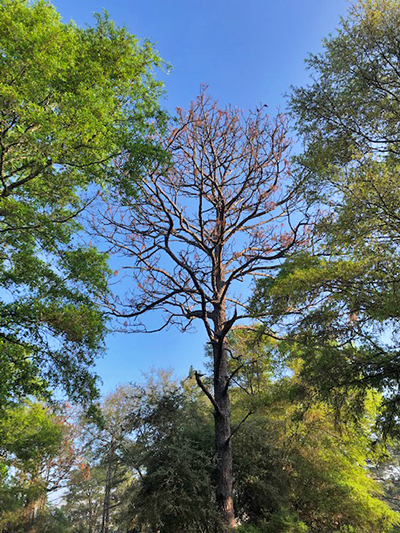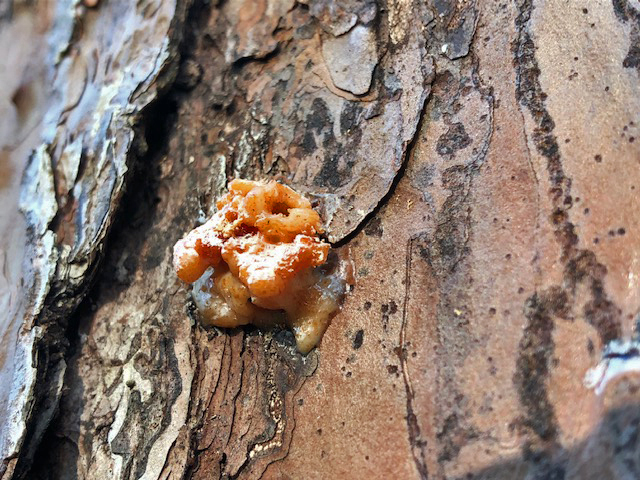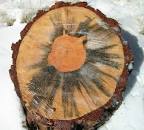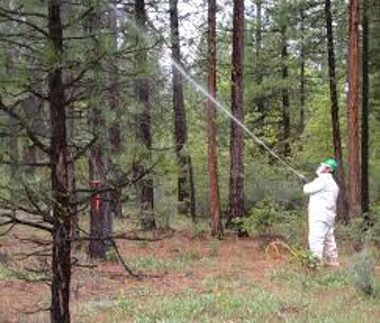Mike Goodchild, Walton County Extension Director & Forestry Agent
Have we reached the peak of pine bark beetle infestations? That is a tough question to answer, but I hope so? This past summer and fall thousands of pine trees succumbed to bark beetles. With Hurricane Michael in 2018 and a late summer drought in 2019, beetle activity increased dramatically across the Panhandle of Florida. Even counties not directly impacted from the Hurricane were affected by this event. There are three main species of bark beetles that attack are pines: black turpentine, Ips, and southern pine. For the most part, the Ips pine engraver beetle has been the culprit recently. All species of pines have been attacked by Ips beetles.
Adult Ips beetles are small, so you rarely see them unless they have been caught in pitch tubes excreted by the pine tree. Immature beetles are larvae that are white in color with brown heads. Male Ips attack the tree first, chewing through the bark and into the cambium layer of the tree. During this process pheromones are released attracting females that lay eggs. These eggs hatch into larvae that begin feeding on the inner bark tissue until emerging from the tree as adults to begin searching for new trees to invade.
–

The four species of Ips bark beetles in the southeastern U.S. and their associated gallery patterns: I. avulsus (A), I. grandicollis (B), I. pini
(C), and I. calligraphus (D). Source: Ips Bark Beetles in the Southeastern U.S.
–
Based on my 30 years of observing the pine forest in Florida, under normal weather conditions, Ips bark beetles only attack lightening-struck trees, trees close to lightening-struck trees, trees damaged by human activity, or old mature trees that are declining. Rarely are small-diameter trees less than 10 years old attacked.
The first signs of infestation are small brown to white resin clumps on the outer bark of the tree. These can occur all the way to the top of the tree, unlike black turpentine beetles that only attack the lower trunk of the tree. The next signs are needles turning yellow to brownish-red to falling off the tree. If you happen to have a portable sawmill, these trees can still be sawn into boards, if you do it before other decay mechanisms invade.
–
Ips beetles also carry spores of bluestem fungi which discolor the wood, but doesn’t cause decay. Blue-stained boards can be made into furniture and other interior uses.
Once the bark beetles leave your tree, secondary invaders like the ambrosia beetle and the pine sawyer beetle take advantage of the openings. Ambrosia beetles leave a light-colored wood dust at the base of the tree. Folks often say they hear a chewing sound in their tree when the pine sawyer beetle is hard at work. These secondary invaders are really of no concern because your tree is already dead when they move in.
In conclusion, it is advisable to remove infected trees whenever possible to help control the spread of beetles and to reduce the dangers associated with dead trees near structures. If you have a favorite old-growth pine in your yard, you may want to consider a bark pesticide surface spray or a systemic treatment to prevent bark beetle damage. These measures are only worth considering if there is bark beetle activity in the area, and the tree is healthy with no signs of beetle damage (If the tree is showing any symptoms you are too late).
For a bark surface spray, apply insecticide to the trunk and all the branches that are 2 inches or greater in diameter. This requires a special sprayer that can reach the top of the tree. Some of the common names of chemicals used are carbaryl, bifenthrin, and permethrin, with trade names of Seven SL, Onyx, and Astro. Some of these insecticides do require a restricted pesticide license for purchase. Always read the label before applying any of these chemicals. For systemic treatments, a tree surgeon that can inject special insecticides directly into the tree. These treatments are expensive unless you can do it yourself.
–
–
–
For additional references, use the following links:
Florida Forest Service: Pine Bark Beetles of Florida
UF/IFAS: Ips Engraver Beetles
Southern Regional Extension Forestry: Ips Bark Beetles in the Southeastern U.S.
- What are the Benefits of Freezer Beef? - August 27, 2021
- Fire Management in a Silvopasture System - March 19, 2021
- Game Cameras for Wildlife Monitoring - October 2, 2020




